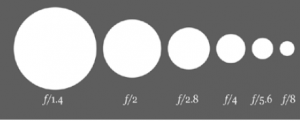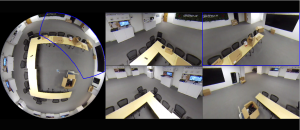Determining what kind of lens to use in a security camera isn’t as difficult as it once was. Because the majority of security cameras today have an integrated, matched lens, a lot of the guesswork has been taken out of lens selection. Yet integrated-lens cameras still require interpretation of conditions specific to the security application, as well as an understanding of the camera’s capabilities. Here, we’ll walk you through best practices for lens selection.
Field of View
The horizontal Field of View (FOV) is dictated by the distance of the lens from the image sensor: see examples here. Before deciding how many megapixels you need, consider what the FOV should be. Once you’ve determined where to install the camera and figured out what the FOV is, consider the resolution you require based on the distance from the subjects. How many Pixels Per Foot (PPF) are necessary?
Say you need 90 PPF so you can get a positive ID on any person in the frame, and you have a 17° field of view. With a 1.3MP camera and a 16mm lens you’ll be able to identify a face at 47 feet, but with a 5MP camera and a 19mm lens, you can identify that same face at 95 feet. Don’t go rushing out to buy a higher-resolution camera unless it’s truly a benefit, though: if the camera is pointed at a wall 25 feet away, you won’t have any faces to ID at 95 feet. Instead you can use a wider-angle lens and get more coverage.
Ambient Light Levels
 Ambient light levels are another important element of the security environment, since it’s crucial to deploy a camera that produces clear images during operational hours. The amount of ambient light present will dictate how much light sensitivity your surveillance system needs. The amount of light able to pass through a lens is indicated by the f-stop number. The smaller the f-stop, the more light that can pass through the lens.
Ambient light levels are another important element of the security environment, since it’s crucial to deploy a camera that produces clear images during operational hours. The amount of ambient light present will dictate how much light sensitivity your surveillance system needs. The amount of light able to pass through a lens is indicated by the f-stop number. The smaller the f-stop, the more light that can pass through the lens.
For security applications that require nighttime illumination, read our blog post about white light LEDs, infrared, and Night Color.
Fixed, Vari-focal, and Autofocus
Motorized vari-focal or zoom lenses provide a convenient way to fine-tune the FOV during or post installation. A motorized vari-focal lens can be adjusted from a computer and will result in a better ROI for the end-user if an application requires frequent lens adjustments. A manual vari-focal lens must be adjusted during installation and requires you to physically focus the lens. While fixed lenses have a fixed focal length and cannot be adjusted, they generally cost less than vari-focal lenses.
You can reduce focus issues significantly by choosing a camera with an autofocus feature. This will eliminate the problem of focus shift as day turns to night. However, if you’re using a wide-angle lens, there’s typically less of a need for autofocus, since so much of the FOV is going to be in focus already.
Fisheye
The wider the FOV, the better the situational awareness — and there’s no wider FOV than 360 degrees. A fisheye  camera can provide up to a 360-degree hemispheric view, letting you see in all directions. An important factor to consider, though, is that fisheye cameras produce considerable optical distortion. The images are best viewed using digital dewarp live or in playback. If possible, use a recorder that has local dewarping: by avoiding in-camera dewarping, everything the camera captures will be recorded for later viewing. On the other hand, in-camera dewarping means that the camera will be compatible with just about any ONVIF recorder. Head over to the Dahua Wiki to see images and video of dewarping modes.
camera can provide up to a 360-degree hemispheric view, letting you see in all directions. An important factor to consider, though, is that fisheye cameras produce considerable optical distortion. The images are best viewed using digital dewarp live or in playback. If possible, use a recorder that has local dewarping: by avoiding in-camera dewarping, everything the camera captures will be recorded for later viewing. On the other hand, in-camera dewarping means that the camera will be compatible with just about any ONVIF recorder. Head over to the Dahua Wiki to see images and video of dewarping modes.
The success of a video surveillance system depends, in part, on the factors that are identified and addressed during its specification and installation. Coverage area, level of image detail needed, and ambient light are important in guiding lens selection. Understanding the advantages of vari-focal and fisheye lenses will help inform your choice of lens as well.
Have more questions? Download and install CameraCalculator, a component of Dahua Toolbox. This desktop software provides a convenient way to calculate focal length, scene width, pixels per foot and distance by camera type, resolution and lens.

